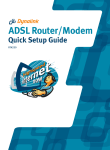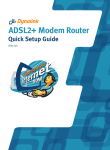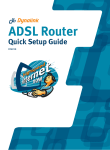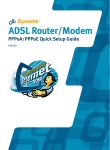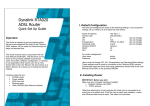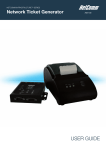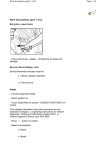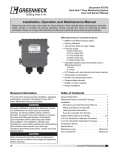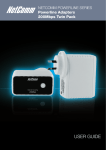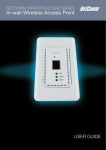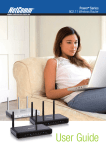Download WLC3010 QSG
Transcript
WLAN PCMCIA Card Quick Setup Guide WLC3010 This Quick Set-Up Guide only provides you with the basic instructions for setting up these wireless adaptors on your computer. A complete User Manual that includes an illustrated step-by-step guide can be found on this CD. WLAN PCMCIA Card Quick Set-up Guide 1 Introduction A Wireless Local Area Network (WLAN) serves the same purposes as a conventional wired Ethernet network (LAN) but only without the wires. Computers are linked together by radio waves. The wireless adaptor is your “wireless network card”. It turns your computer into a wireless station, allowing it to connect to other wireless stations or wireless access points to share network resources including Internet access. THIS PRODUCT CAN BE SET UP ON TWO TYPES OF WIRELESS NETWORKS 1. Infrastructure network In an infrastructure network, your wireless adaptor connects your computer to a wired network via a wireless access point. This enables your computer to share all available resources including Internet access and peripherals on the wired network. 2. Ad-hoc (peer to peer) network This is a computer network built of wireless stations. Your wireless adaptor connects your computer to other wireless stations for file sharing. WIRELESS PRIVACY Privacy is an important issue with wireless. These functions are provided for access control and security: 1. Service Set ID (SSID) or Network ID This is a user specified name that uniquely identifies a wireless domain. You must set your wireless adaptor to use the SSID for the wireless network. 2. Wired Equivalent Privacy (WEP) is an authentication algorithm that protects users from eavesdropping. When enabled, all wireless stations always transmit data encrypted using a key of your choice. The receiving station will use the same key for decryption. 2 Installing the Wireless Adaptor IMPORTANT: Do not insert the wireless adaptor into your computer before installing the supplied software from the manufacturer’s CD. If you insert before installing the software Windows would pop up a message box requesting a driver. Click Cancel, and remove the card to proceed. Chapter 2 on pages 9-14 of the User Manual provides illustrations for the steps outlined here. 1. Exit from all currently running programs. 2. Insert the provided manufacturer’s CD into your drive. A menu will launch. If it fails to load automatically, click Start > Run and enter d:\utility&driver\setup.exe (substitute d: with your CD drive letter) then OK. 3. Select the Utility & Driver option from the menu. 4. Click Next and accept the License Agreement. 5. To install the software to the default destination folder, click Next. You can also specify a different location. 6. Click next on the Found New Hardware window, and then follow the on screen instructions, you will be asked to insert the adaptor. Click Finish to complete installation. Windows may ask to restart. Notes: 1. Windows 98 users – the system may ask to insert the Windows 98 CDROM. 2. If Windows asks to identify the location of the driver, direct the installation wizard to the C:\Program Files\WLAN\Driver\PCMCIA, or the location you may have specified differently in step 5. WLAN PCMCIA Card Quick Set-up Guide 3 Accessing the Wireless LAN Utility Chapter 3 on pages 15 of the User Manual provides a detail step-by-step guide with illustrations. NOTE FOR WINDOWS XP USERS ONLY. Windows XP comes with built in Wireless Zero Configuration Utility for wireless configuration and monitoring. It is recommended that you disable this Windows utility and use only the vendor’s utility supplied here to configure the wireless adaptor. Refer to Chapter 5 of the User Manual for set up if you prefer to use Windows default utility. To disable the Windows XP wireless utility, 1. Double click the Windows wireless icon on taskbar, then select Advanced (or Properties) > Wireless Networks. 2. On the Wireless Networks tab, uncheck the Use Windows to configure my wireless network settings box and click OK. From this point on, you only need to use the hardware vendor’s wireless utility. FOR ALL USERS 1. Run the vendor’s wireless LAN utility from Windows taskbar and select the Configuration tab. 2. Click the New button and configure the settings: Profile Name: Enter a name of your choice to identify your current settings. Operating Mode: Select Infrastructure or Ad-Hoc (peer-to-peer). You must select infrastructure if you are connecting to a wireless access point or wireless router. Network Name: Specify the name of the WLAN group on air you want to associate. Peer-to-Peer Channel: Select the channel for your wireless network (AdHoc mode ONLY). In infrastructure mode, the channel is already determined by the access point. Transmit Rate: Select the speed of the data transmission. The default Fully Automatic setting allows the wireless adaptor to adjust adaptively its data rate in relation to the signal strength. 3. Click Apply to enable your settings. Click Link Status to check that the wireless adapter has successfully associated with your target access point. 4 Setting Up Wireless Privacy 4.1 WEP WEP is for protection against eavesdropping and prevention of access from unauthorised wireless stations. Both 64 and 128 bit encryption are supported. The 128 bit option is more secure but it impacts more on the effective throughput of the network than the 64 bit option. The WEP setting is already determined on an existing network by the network administrator. Only if you are setting up a new network there is the option on the WEP setting. Before you start you should have known: 1. The type of encryption, 64 or 128-bit. 2. The encryption keys. 3. The key number to be used. 4. Open or shared key authentication. These settings must be identical to those on the access point or wireless stations. If the wireless network you are connecting to uses no encryption, go to Encryption and check that the setting is disabled. If the network is protected by WEP: 1. Run the vendor’s wireless LAN utility from Windows taskbar and select Encryption. 2. Select 64 bits or 128 bits key length. 3. From the Type list, select the required authentication type. (You should use the same authentication method as used by your target wireless network.) Open Key: If the wireless network uses Open Key, authentication request will be always accepted. Shared Key: If the wireless network uses Shared Key, your wireless adapter must be set to use correct WEP to pass the authentication. If selected, your wireless adapter must use identical WEP keys as the target wireless network. 4. With Create Keys Manually selected, choose Alphanumeric or Hexadecimal as the key format and then enter up to four keys in the provide fields. 5. From the Use WEP Key list select which key you want to use to encrypt your transmitting data. 6. After you finished all the encryption settings, click Apply to activate the changes. After clicking Apply the setting take effect immediately and you will be led to the Link Status tab. You can check whether your wireless adaptor has successfully associated with your target access point or another wireless station. WLAN PCMCIA Card Quick Set-up Guide 4.2 MAC ADDRESS FILTERING OR ASSOCIATION CONTROL 5 Some access points block access from unauthorised clients by registering the MAC address of all authorised clients. If the network uses this function, you must supply the MAC address of your adaptor to the network administrator for inclusion into the access point. The MAC address of your adaptor is printed on a barcode label affixed to the product. The label reads MAC:009096-xxxxxx. 009096 is the first half of the address. Uninstalling the device and software The procedure is to uninstall the software and then remove the hardware from your computer. Always disable the utility by right-clicking the wireless utility icon and select Exit. The icon will disappear indicating that the utility is not in operation. UNINSTALLING THE WIRELESS ADAPTOR SOFTWARE 1. Close all programs that are currently running. 2. Click the Windows Start button, point to Programs, WLAN Utility and then click Uninstall Utility. 3. Click OK to proceed with software removal. 4. Click Finish to complete uninstall. Windows may ask to restart. REMOVING THE WIRELESS ADAPTOR HARDWARE It is recommended that you follow the standard Windows procedure for removing a PCMCIA device from your computer. 1. Double click the Safely Remove Hardware icon on taskbar. 2. Select the device you want to remove, click Stop and then OK. 3. When the safe to remove message is displayed, click OK and remove device. 6 Troubleshooting 1. Cannot connect to access point (infrastructure mode) or other wireless stations (ad-hoc mode) Check that the POWER light on the adaptor is on. Make sure the adaptor and access points/wireless stations are using the same SSID. In infrastructure mode if MAC address filtering (see section 4.2) is enabled at the access point, contact the network administrator to include your adaptor’s MAC address into the list of authorised clients. If WEP is used, make sure the same encryption (64- or 128-bit) is selected and the same WEP key table has been entered. Incorrect IP Address or Subnet Mask. Check these settings in the TCP/IP Properties dialog box in the Network Configuration tab. Restart computer. 2. How to find the MAC addresses of my adaptor The MAC address of your adaptor can be read off from a barcode label affixed on the product. The label reads MAC:009096-xxxxxx. 009096 is the first half of the address. If the adaptor is already installed, alternatively go to the DOS prompt (Click on Start, select RUN. Type in command, and click OK), type ipconfig /all. The MAC address is shown under physical address as a group of 6 double digits. 3. Poor Link Quality If the link quality is poor, it may be due to one of these reasons: Radio interference. Distance between adaptor and access point/wireless station is too far. 4. How to avoid radio interference Other wireless devices and appliances on site may share the same 2.4 GHz band. If undesirable effects are observed, try using a different channel. Alternatively, switch the other devices to use a different channel. Also try the following: Move the computer to a different location or orientation. If adaptor is USB, move the adaptor instead of computer. If the radio interference source is known, increase the separation between the wireless computers and the device causing the interference. Do not share the same AC power socket between the computer and the device generating the interference. Stay away from microwave sources (including microwave oven) and large metal objects. Warranty Dynalink warrants this product against defects in materials and workmanship for a period of twelve months from the original date of purchase. We will, at our discretion, repair or replace the faulty unit, free of charge, provided it is returned to us with proof of purchase from an authorised dealer within the warranty period. Return delivery after repair will be paid for by Dynalink. We reserve the right not to repair or replace goods that: have been mishandled, abused or not installed according to the guidelines as outlined in the instructions. have been subjected to a power surge from other equipment or other external factors. have been altered or modified. Help Always check that your hardware is installed correctly. Check our web site for the latest information and troubleshooting guide. If you have difficulties, contact Dynalink Technical Support for issues relating to installation and operation. If possible, visit Dynalink's on-line support area at: New Zealand www.dynalink.co.nz/support Australia www.dynalink.com.au/support Contact Dynalink’s Technical Support: New Zealand Australia Phone 0800 653 962 Phone 1800 653 962 Fax 0800 503 962 Fax 1800 063 962 (Monday-Friday: 8:30am-7:30pm) (Monday-Friday: 8:30am-5:30pm) NZAUWLC3010- QG2








